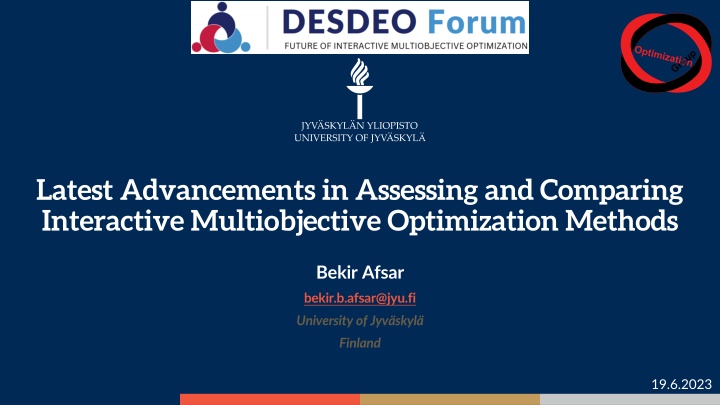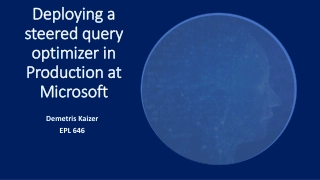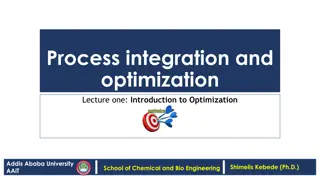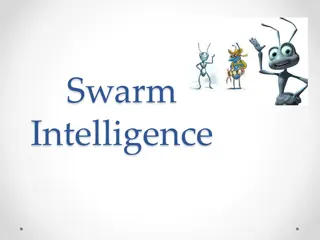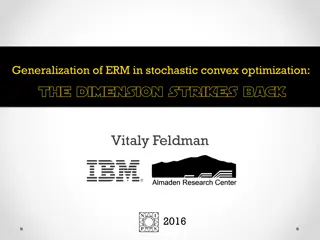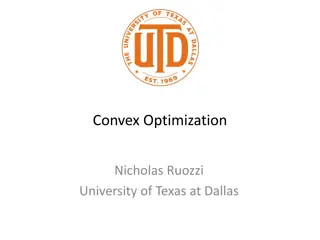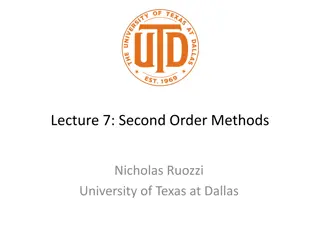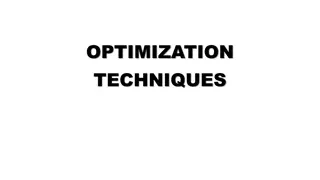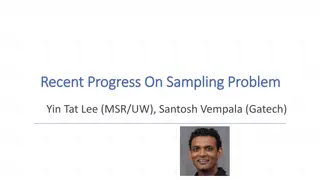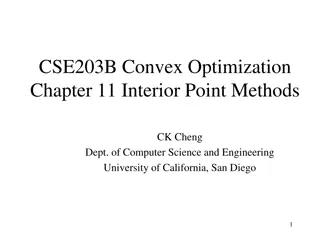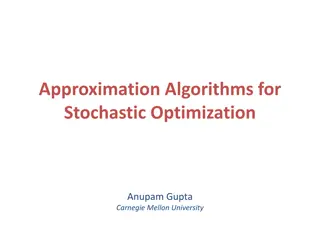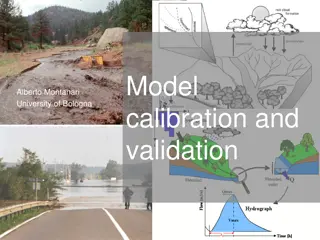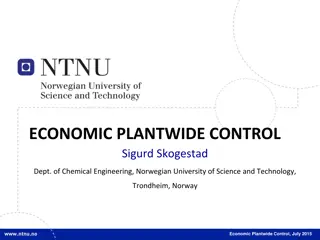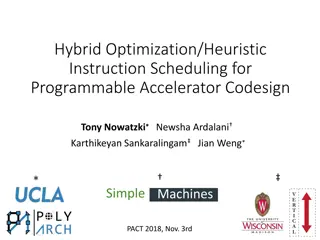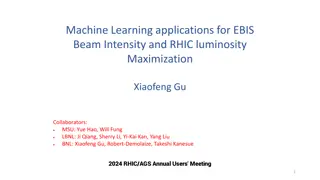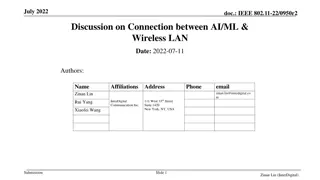Latest Advancements in Interactive Multiobjective Optimization Methods
This article explores the latest advancements, challenges, and comparisons of interactive multiobjective optimization methods in decision-making processes.
Download Presentation

Please find below an Image/Link to download the presentation.
The content on the website is provided AS IS for your information and personal use only. It may not be sold, licensed, or shared on other websites without obtaining consent from the author.If you encounter any issues during the download, it is possible that the publisher has removed the file from their server.
You are allowed to download the files provided on this website for personal or commercial use, subject to the condition that they are used lawfully. All files are the property of their respective owners.
The content on the website is provided AS IS for your information and personal use only. It may not be sold, licensed, or shared on other websites without obtaining consent from the author.
E N D
Presentation Transcript
Latest Advancements in Assessing and Comparing Interactive Multiobjective Optimization Methods Bekir Afsar bekir.b.afsar@jyu.fi University of Jyv skyl Finland 19.6.2023
Outline Introduction Systematic review of assessing interactive methods Desirable properties of interactive methods Challenges in comparing interactive methods Comparing with artificial decision makers (ADMs) Comparing with human decision makers Conclusions 2
Introduction Many interactive methods have been proposed in the literature*: types of preference information, ways to exchange the information between the method and the DM, mechanisms for solving subproblems, stopping criteria. * Miettinen, K., Hakanen, J., & Podkopaev, D. (2016). Interactive nonlinear multiobjective optimization methods. In Multiple Criteria Decision Analysis (2nd ed.), Salvatore Greco, Matthias Ehrgott, and Jos Rui Figueira (Eds.). Springer, NewYork, 927 976. 3
Introduction Ad-hoc vs non ad-hoc methods DM can be replaced by utility/value function in non ad-hoc methods. In ad-hoc methods, this is not possible E.g., reference points cannot be adjusted via utility/value functions during the interactive solution process. Two phases of interactive solution processes: In the learning phase, the DM explores different solutions to identify a region of interest. In the decision phase, the DM fine-tunes the search in the region of interest to find the most preferred solution. 4
Motivation to assess and compare interactive methods How to select an interactive method to apply in real-world applications? How to assess their performances? How to compare them? 5
Outline Introduction Systematic review of assessing interactive methods Desirable properties of interactive methods Challenges in comparing interactive methods Comparing with artificial decision makers (ADMs) Comparing with human decision makers Conclusions 6
Comparing interactive methods Which method is the most suitable one to apply for a given problem? We conducted an extensive literature survey*on the assessment of interactive multiobjective optimization methods. What has been done in assessing interactive methods? What has been measured and how? What could be measured? Desirable properties that characterize the performance of interactive methods. * Afsar, B., Miettinen, K., & Ruiz, F. (2021). Assessing the performance of interactive multiobjective optimization methods: A survey. ACM Computing Surveys, 54(4), article 85, 1-27. 7
Desirable properties of interactive methods General properties*: GP1 - The method captures the preferences of the DM. GP2- The method sets as low cognitive load on the DM as possible. GP3 - A user interface supports the DM in problem solving. GP4 - The DM feels being in control while interacting with the method. GP5- The method prevents premature termination of the overall solution process. * Afsar, B., Miettinen, K., & Ruiz, F. (2021). Assessing the performance of interactive multiobjective optimization methods: A survey. ACM Computing Surveys, 54(4), article 85, 1-27. 8
Desirable properties of interactive methods Desirable properties for the learning phase*: LP1- The method helps the DM avoid anchoring. LP2- The method allows exploring any part of the Pareto optimal (PO) set. LP3- The method easily changes the area explored as a response to a change in the preference information given by the DM. LP4- The method allows the DM to learn about the conflict degree and tradeoffs among the objectives in each part of the PO set explored. LP5- The method properly handles uncertainty of the information provided by the DM. LP6- The method allows the DM to find one's region of interest at the end of the learning phase. * Afsar, B., Miettinen, K., & Ruiz, F. (2021). Assessing the performance of interactive multiobjective optimization methods: A survey. ACM Computing Surveys, 54(4), article 85, 1-27. 9
Desirable properties of interactive methods Desirable properties for the decision phase*: DP1- The method allows the DM to be fully convinced that (s)he has reached the best possible solution at the end of the solution process. DP2- The method reaches the DM's most preferred solution. DP3- The method allows the DM to fine-tune solutions in a reasonable number of iterations and/or reasonable waiting time. DP4- The method does not miss any PO solution that is more preferred for the DM than the one chosen. * Afsar, B., Miettinen, K., & Ruiz, F. (2021). Assessing the performance of interactive multiobjective optimization methods: A survey. ACM Computing Surveys, 54(4), article 85, 1-27. 10
Challenges in comparing interactive methods* Comparing with human DMs: Human fatigue, the subjectivity of DMs, or other limiting factors. DM learns during the solution process and order of methods is important. We need many DMs who use methods in different orders. Comparing with utility/value functions: Some aspects of interactive methods can be assessed without involving humans, whereas others, such as usability and cognitive load can only be assessed with human participants. We can only compare non ad-hoc methods. Do not capture all properties of human behavior like anchoring or learning. Comparing with artificial DMs (ADMs) Quality indicators for interactive methods are needed. *Afsar, B., Miettinen, K., & Ruiz, F. (2021). Assessing the performance of interactive multiobjective optimization methods: A survey. ACM Computing Surveys, 54(4), article 85, 1-27. 11
Outline Introduction Systematic review of assessing interactive methods Desirable properties of interactive methods Challenges in comparing interactive methods Comparing with artificial decision makers (ADMs) Comparing with human decision makers Conclusions 12
Comparing with ADMs Experimenting with ADMs is cheaper and can be repeated many times. less time consuming than experimenting with real DMs. can support real DMs in finding the most appropriate method for a given problem before the actual solution process. can support researchers in comparing their interactive method with existing ones. cannot measure practical aspects, e.g., user interfaces. We proposed two ADMs to compare the performance of interactive methods considering the following desirable properties: LP2(Exploring PO), LP3(Responsiveness), DP2(Most preferred solution) 13
ADMs for comparing interactive evolutionary methods Properties of the proposed ADM*and ADM-II**: They run all algorithms to be compared simultaneously Provide the same computation resources (e.g., number of function evaluations or generations per iteration). They build the composite front first merges the obtained solutions then eliminates the dominated ones They determine the least and best-explored area of the composite front based on the assigned number of solutions to the uniformly distributed vectors. * Afsar, B., Miettinen, K., & Ruiz, A. B. (2021). An artificial decision maker for comparing reference point based interactive evolutionary multiobjective optimization methods. In Ishibuchi, H., Zhang,Q., Cheng, R., Li, K., Li, H., Wang, H., and Zhou, A., editors, Evolutionary Multi-Criterion Optimization, EMO 2021, 12654, 619-631, Cham. Springer International Publishing. ** Afsar, B., Ruiz, A. B., & Miettinen, K. (2021). Comparing interactive evolutionary multiobjective optimization methods with an artificial decision maker. Complex & Intelligent Systems, 1-17. 14
ADMs for comparing interactive evolutionary methods Both ADMs differentiate the learning and the decision phase: In the learning phase, they explore the different parts of the objective space. In the decision phase, they aim to refine solutions inside the region of interest (which is defined at the end of the learning phase). ADM can generate only reference points, while ADM-II can generate different types of preference information: Selecting the preferred solutions |d|: Distance from the ideal point |d |: Distance from the nearest point Selecting the non-preferred solutions Specifying preferred ranges Performing pairwise comparisons 15
Performance evaluation There are no quality indicators developed for assessing interactive methods. ADMs evaluate the performances of interactive methods after each iteration by using indicators developed for reference point based evolutionary multiobjective optimization methods, where preferences are provided a priori, before the solution process. We used R-metric* as the indicator. ADMs find cumulative indicator values for the learning phase and decision phase. *Li, K., Deb, K., & Yao, X. (2017). R-metric: Evaluating the performance of preference-based evolutionary multiobjective optimization using reference points. IEEE Transactions on Evolutionary Computation, 22(6), 821-835. 16
Outline Introduction Systematic review of assessing interactive methods Desirable properties of interactive methods Challenges in comparing interactive methods Comparing with artificial decision makers (ADMs) Comparing with human decision makers Conclusions 17
Comparing with human DMs Practical applicability can only be measured by human participants. Several human subjects (and randomization) are needed to avoid the effect of the learning transfer. Students, domain experts, and researchers can participate as DMs. What do we need? Questionnaire Sufficient number of participants An optimization problem which has a meaning for the participants Proper experimental design 18
Experimental studies to compare interactive methods with human participants We proposed novel questionnaires*,** to assess How extensive is the cognitive load of the whole solution process? GP2(Cognitive load) DP3(# of iterations / waiting time) How well does the method capture and respond to the DM s preferences? GP1 (Capturing preferences) GP4 (Being in control) LP3(Responsiveness) Is the DM satisfied with the overall solution process and confident with the final solution? LP4(Learning tradeoffs) DP1(Convinced) DP4(Not missing PO) * Afsar, B., Silvennoinen, J., Misitano, G., Ruiz, F., Ruiz, A. B., & Miettinen, K. (2022). Designing empirical experiments to compare interactive multiobjective optimization methods. Journal of the Operational Research Society, to appear. ** Afsar, B., Silvennoinen, J., Misitano, G., Ruiz, F., Ruiz, A.B., & Miettinen, K. An experimental design for comparing interactive methods based on their desirable properties. Under review. 19
Experimental design and setup We reported the complete questionnaire and design* to make the experimental setup reusable. We used the within-subjects design. We proposed a novel multiobjective optimization problem analyses the sustainability situation of Finland. We conducted a proof-of-concept experiment at the University of Jyv skyl . * Afsar, B., Silvennoinen, J., Misitano, G., Ruiz, F., Ruiz, A. B., & Miettinen, K. (2022). Designing empirical experiments to compare interactive multiobjective optimization methods. Journal of the Operational Research Society, to appear. 20
Experimental design and setup We reported the complete questionnaire and design* to make the experimental setup reusable. We used the between-subjects design. We used the same multiobjective optimization problem analyses the sustainability situation of Spain. We conducted an experiment at the University of Malaga. * Afsar, B., Silvennoinen, J., Misitano, G., Ruiz, F., Ruiz, A.B., & Miettinen, K. An experimental design for comparing interactive methods based on their desirable properties. Under review. 21
Results The satisfaction of participant s own performance: E-NAUTILUS > NIMBUS > RPM The easiness of exploring different solutions: E-NAUTILUS > NIMBUS > RPM Reflecting preferences well: NIMBUS > E-NAUTILUS > RPM Satisfaction with the final solution: NIMBUS > E-NAUTILUS > RPM The frustration level: NIMBUS > RPM > E-NAUTILUS The required mental activity: RPM > NIMBUS > E-NAUTILUS The tiredness level: RPM > NIMBUS > E-NAUTILUS Convinced that they found the best possible solution: NIMBUS > E-NAUTILUS > RPM 22
Outline Introduction Systematic review of assessing interactive methods Desirable properties of interactive methods Challenges in comparing interactive methods Comparing with artificial decision makers (ADMs) Comparing with real decision makers Conclusions 23
Conclusions Comparing interactive methods is important but has many challenges. ADMs may help in comparing interactive methods quantitatively. Qualitative (practical) aspects can only be measured with human participants. We need quality indicators specifically designed for interactive methods. We proposed a set of desirable properties of quality indicators for interactive methods*. We recently proposed a preference-based hypervolume indicator for assessing interactive methods**. * Aghei Pour, P., Bandaru, S., Afsar, B., & Miettinen, K. (2022, July). Desirable properties of performance indicators for assessing interactive evolutionary multiobjective optimization methods. In Proceedings of the Genetic and Evolutionary Computation Conference Companion (pp. 1803-1811). ** Aghei Pour, P., Bandaru, S., Afsar, B., Emmerich, M., & Miettinen, K. (2023). A performance indicator for interactive evolutionary multiobjective optimization methods. IEEE Transactions on Evolutionary Computation, to appear. 24
Thank you! DESDEO framework https://desdeo.it.jyu.fi/ Multiobjective Optimization Group http://www.mit.jyu.fi/optgroup/ Bekir Afsar bekir.b.afsar@jyu.fi Twitter: https://twitter.com/BeAfsar LinkedIn: linkedin.com/in/bekirafsar Acknowledgements The research is related to the thematic research area DEMO (Decision Analytics utilizing Causal Models and Multiobjective Optimization, jyu.fi/demo) of the University of Jyvaskyla. This research was partly funded by the Academy of Finland (grants 311877 and 322221).
